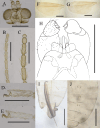Recent Divergence of Neolitsea-associated Pseudasphondylia Gall Midges (Diptera: Cecidomyiidae) with Description of a New Species from Taiwan
- PMID: 41064790
- PMCID: PMC12500453
- DOI: 10.6620/ZS.2025.64-09
Recent Divergence of Neolitsea-associated Pseudasphondylia Gall Midges (Diptera: Cecidomyiidae) with Description of a New Species from Taiwan
Abstract
Taiwanese Pseudasphondylia species inducing spherical leaf galls on six Neolitsea hosts, viz, N. acuminatissima, N. daibuensis, N. konishii, N. parvigemma, N. sericea and N. variabillima, was regarded as a species allied to Japanese P. neolitseae Yukawa due to similarity of gall structure and host. The Taiwanese species is morphologically different from P. neolitseae in adult palpus segmental number, shapes of pupal antennal horn, pupal prothoracic spiracle, and larval sternal spatula, resulting in its description as a new species to science, Pseudasphondylia hooki sp. n. The species delimitation (Assemble Species by Automatic Partitioning method) supported that P. hooki sp. n. is distinct from P. neolitseae. The sistership of P. hooki sp. n. and P. neolitseae was also supported in the Maximum likelihood tree based on the 1st codon of COI region. The speciation event of them is assumed to be geographical isolation because the divergence corresponded to the separation of Taiwan and Japan in the Pleistocene. The patterns of ecological features (host species) on the phylogeny revealed that galling on N. sericea is primitive of Neolitsea-associated Pseudasphondylia lineage. Accordingly, the divergence pathway from north to south in Taiwan is suggested by the distributions of primitive (N. sericea) and most derived hosts (N. daibuensis).
Keywords: Asphondyliina; Biogeography; East Asia; Phylogeny; Speciation.
Figures





References
-
- Brower AVZ. 1994. Rapid morphological radiation and convergence among races of the butterfly Heliconius erato inferred from patterns of mitochondrial DNA evolution. Proc Natl Acad Sci USA 91:6491–6495. doi:10.1073/pnas.91.14.6491. - DOI - PMC - PubMed
-
- Cameron SL, Lambkin CL, Barker SC, Whiting MF. 2007. A mitochondrial genome phylogeny of Diptera: whole genome sequences resolve relationships over broad timescales with high precision. https://doi.org/10.1111/j.1365-3113.2006.00355.x Syst Entomol <ext-link xmlns:xlink="http://www.w3.org/1999/xlink" ext-link-type="uri" xlink:href="https://doi.org/10.1111/j.1365-3113.2006.00355.x">32:</ext-link> 40–59. doi:10.1111/j.13653113.2006.00355.x. - DOI - DOI - DOI - DOI - DOI
-
- DeSalle R, Freeman T, Prager EM, Wilson AC. 1987. Tempo and mode of sequence evolution in mitochondrial DNA of Hawaiian Drosophila. J Mol Evol 26:157–164. doi:10.1007/BF02111289. - DOI - PubMed
-
- Elsayed AK, Yukawa J, Tokuda M. 2018. A taxonomic revision and molecular phylogeny of the eastern Palearctic species of the genera Schizomyia Kieffer and Asteralobia Kovalev (Diptera: Cecidomyiidae: Asphondyliini), with descriptions of five new species of Schizomyia from Japan. Zookeys 808:123–160. doi:10.3897/zookeys.808.29679. - DOI - PMC - PubMed
-
- Elsayed AK, Nemoto S, Tokuda M. 2023. Pseudasphondylia ishigakiensis, a new gall midge species (Diptera: Cecidomyiidae) from Japan developing in flower buds of Melicope triphylla (Rutaceae), with notes on its life history. J Asia-Pacific Entomol 26:102107. doi:10.1016/j.aspen.2023.102107. - DOI
LinkOut - more resources
Full Text Sources
